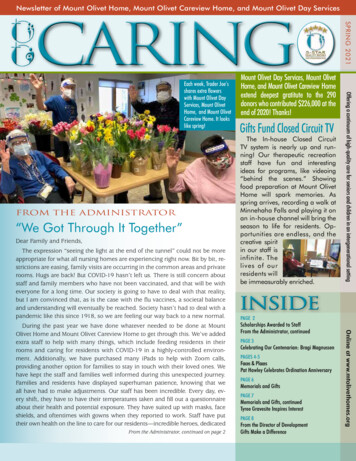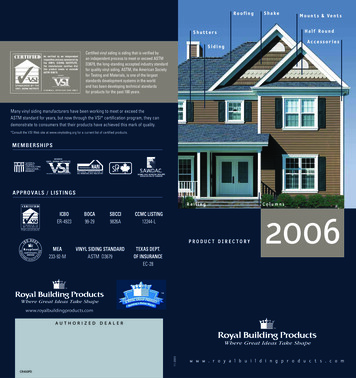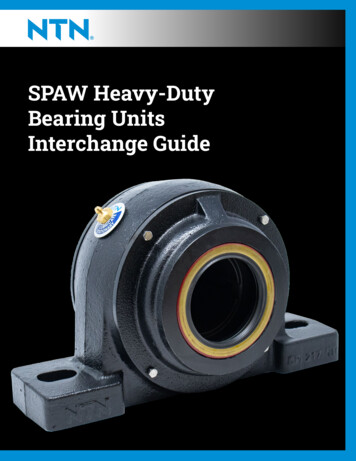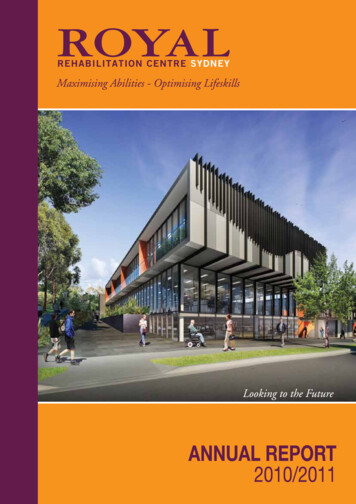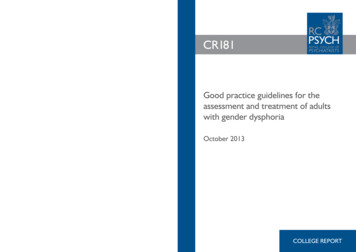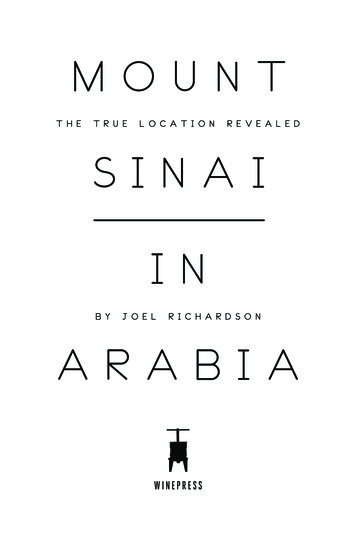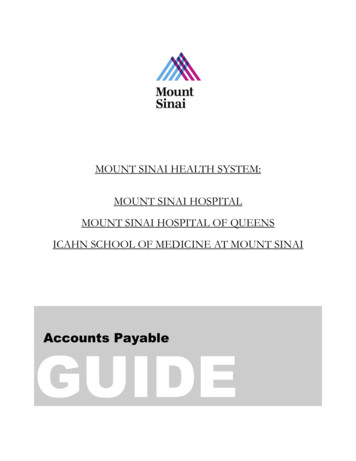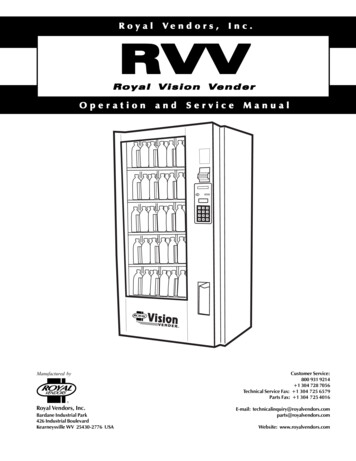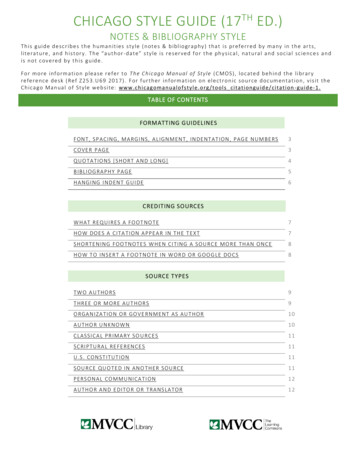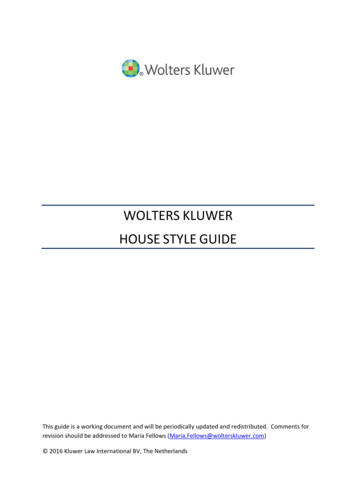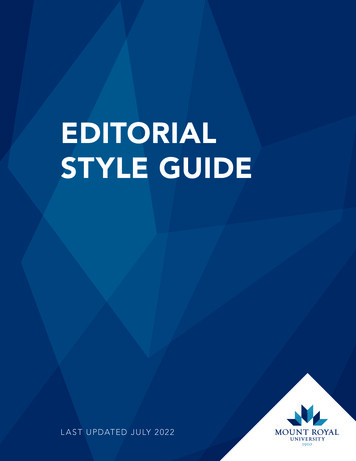
Transcription
EDITORIALSTYLE GUIDEL A S T UPDATED JULY 2 02 2
TABLE OF CONTENTSINTRODUCTION TO MOUNT ROYAL . 5Vision . 5Mission . 5Our brand promise . 5Our brand pillars. 5Our brand voice . 5INTRODUCTION TO THE MOUNT ROYAL WRITING STYLE. 6Writing with Mount Royal’s brand in mind. 6Logo.6Plain language writing. 7Privacy considerations for Mount Royal materials. 7Recommended spelling and style reference materials. 8Use of Canadian spelling.8Use of the Oxford (or serial) comma.8Questions and suggestions for the Editorial Style Guide. 8MOUNT ROYAL TERRITORIAL ACKNOWLEDGEMENT. 9COMMONLY MISUSED WORDS AND PHRASES. 10MOUNT ROYAL AND ACADEMIA-SPECIFIC REFERENCES. 13List of common terms at Mount Royal. 13Mount Royal and academia-specific references.13Faculties. 13Centres . 14Institutes. 14Degrees. 14Diplomas. 14Certificates. 14Degree/diploma access routes. 14Occupational diplomas and certificates. 15Residencies. 15Administration.15Buildings.16Landmarks, rooms and theatres.16Campus services.17Other Mount Royal terms.18Mount Royal’s history. 20Mount Royal’s centennial.20Mount Royal founder Dr. George W. Kerby.202MOUNT ROYAL UNIVERSITY EDITORIAL STYLE GUIDE
Referencing Mount Royal. 20First reference of Mount Royal in a written work.20Mount Royal College.20Mount Royal governance.21Department and faculty names.21Room names and room numbers at Mount Royal.21Other academic institutions.21Undergraduate, graduate and post-graduate definitions.21Referencing degrees.22Degree abbreviation guidelines. 22Degrees in general. 22Specific degrees. 22Honours and applied degrees. 22Use of abbreviations and apostrophes in degree referencing. 22Referencing majors and minors.23Capitalization of majors and minors. 23Referencing honorary degree/doctorate recipients. 23Honorary degrees.23Honorary doctorates.23Referring to Mount Royal faculty, professors and instructors. 24Professors and instructors holding a PhD.24Using the term “instructor”.24Using the term “teacher”.24Capitalization of professorial titles.25Endowed chair holders.25Emeritus and emerita status.25Referencing faculty degree credentials. 26Referencing more than one degree credential.26PhD credentials.26WEBSITE WRITING STYLE AND PAGE FORMATTING. 27URL formatting. 27Non story-based or blog-based content. 27Writing for the web. 28Writing for all social media platforms representingMRU using text content. 28Page formatting. 28Writing in English for a multilingual audience. 29NUMBERS, DATES AND TIMES. 30Numbers. 30Numbers with words and/or numerals.30Numbers over one e numbers.31MOUNT ROYAL UNIVERSITY EDITORIAL STYLE GUIDE3
Dates, times and places. 31Abbreviating day and month references.31Formatting date and time references.31Commas in date references. 31Alphanumeric combinations in date references. 32Alphanumeric combinations in time references. 32En dashes to convey time duration. 32Country, province and territory abbreviations.32Street address abbreviations.32PUNCTUATION AND FORMATTING. 33Accents. 33Ampersands. 33Bulleted and numbered lists. 33Creating sub-levels in lists.33Capitalization and periods within bulleted lists.34Commas. 34Ellipses. 34Em and en dashes. 34Em dashes to set off clauses within sentences.34En dashes to convey duration.34Formatting em and en dashes.35Exclamation marks. 35Hyphens. 35Italics. 35Published materials and other entities.35Legislation.35TV shows and movie titles.36Non-English words.36Lists. 36Preferred font. 36Quotation marks. 36Single quotation marks.36Double quotation marks.36Partial quotations.37Punctuation placement beside double quotation marks.37Spaces and spacing. 37CAPITALIZATION. 35Academic year and semesters. 38Generic Mount Royal references. 38Headlines. 39Occupation titles and faculty. 39Races and ethnic groups. 39University. 394MOUNT ROYAL UNIVERSITY EDITORIAL STYLE GUIDE
INTRODUCTION TO MOUNT ROYALINTRODUCTIONTO MOUNT ROYALVISIONMount Royal University: an exceptional undergraduate educational experience.MISSIONSince 1910, Mount Royal has built a reputation on a strong, liberal education foundationwith an undergraduate focus. More than a century later, we remain responsive to theneeds of our community through our enduring commitment to this legacy. We are acommunity of engaged citizens providing personalized, experiential and outcomebased learning in an environment of inclusion, diversity and respect. Through our focuson teaching and learning informed by scholarship, we are preparing our graduates forsuccess in their careers and lives.OUR BRAND PROMISEAt Mount Royal, students will experience a high-quality education enhanced bypersonalized learning, experiential opportunities and a single-minded dedication topremier undergraduate learning.OUR BRAND PILLARSAt Mount Royal, we are committed to four brand pillars:»»»»Provide personalized learningBe outcome focusedDeliver quality teachingBe community responsiveOUR BRAND VOICEAt Mount Royal, our brand voice The brand voice is used in all written materials at Mount Royal University, and employeesare also expected to represent the “You Belong Here” brand concept, which wasdeveloped to project Mount Royal’s best attributes paired with its brand promise, pillarsand voice.MOUNT ROYAL UNIVERSITY EDITORIAL STYLE GUIDE5
INTRODUCTION TO THE MOUNT ROYAL WRITING STYLEINTRODUCTION TOTHE MOUNT ROYALWRITING STYLEEvery large institution strives for consistency and professionalism in its written materials.Clear and effective written communications help enhance Mount Royal University’sacademic credibility with students, prospective students and their parents, academicpeers, industry partners, potential funders and our community.Use this guide as you are writing or editing anything for large-scale distribution tointernal and/or external audiences.Examples include:»»»»»Official internal and external correspondencePromotional brochures, ads and other marketing materialsReports and communications materialsOur Community, mtroyal.ca, myMRU.ca announcments and event listingsMeeting minutes and presentationsNOTE: The Editorial Style Guide is not intended for use in scholarly, research oracademic writing, which will have particular guidelines and styles you should follow.This editorial and Indigenous style guide was developed by the Marketing andCommunications department. We have consulted sources such as the Canadian PressStylebook — recognized across Canada as the authoritative source for effective writtencommunication — and we have reviewed style guides from other Canadian universities(see page 8 for more about the Canadian Press Stylebook).WRITING WITH MOUNT ROYAL’SBRAND IN MINDMount Royal University is personal, approachable, responsive and authentic in the waywe educate and interact with those we serve — and those we work with — on a dailybasis. These attributes should be reflected in your writing as well.»»»»»»»»Personal rather than formalEnthusiastic rather than reservedEnergetic rather than laid backStudent-focused rather than institution-focusedProfile- and story-driven rather than corporatePersonal: use “you” rather than “students”; “our” rather than “Mount Royal’s”Address people by their name and sign off with your own — in person, on the phoneor in an emailShow rather than tell — use quotes or examples to prove a pointLogoPlease refer to the brand guidelines located at mru.ca/Logo for instructions around theproper use of the Mount Royal University name, logo and official marks.6MOUNT ROYAL UNIVERSITY EDITORIAL STYLE GUIDE
INTRODUCTION TO THE MOUNT ROYAL WRITING STYLEPLAIN LANGUAGE WRITINGPlain language writing is the preferred method of written communication. Keep it simpleand straightforward. Plain language is easy to understand, direct, accessible and free ofjargon.Here are some basic guidelines for writing in plain language:»Know your audience. Consider who will be reading what you’re writing and why.This will help you tailor your content to the reader.»Write in the active voice. Use basic subject-verb sentence structure: Kim kicked theball versus the ball was kicked by Kim. When a verb is in the active voice, the subjectof the sentence is also the doer of the action. Active voice is easier to understand,and by using it you are more likely to engage the reader.»Write short sentences. The shorter the sentence, the easier it is to read. Be concise.Be clear. Be short. Omit unnecessary words.»“Use” simple words — don’t “utilize” simple words. If you have two word options,use the simpler of the two. Easy writing is easy reading.»Use headings and subheadings to structure your ideas. Break your writing up intological sections and link it through the appropriate headings/subheadings. Becausemost readers scan, subheads allow them to find the information they are looking forfaster.»Be organized. Make your paragraphs short and concise by completely articulating athought and ensure it links with the paragraphs preceding and following it.»Avoid introducing unfamiliar acronyms if they are to be used only once or twice.When in doubt, spell out the whole name. Unless referencing well-known acronymsthat require no introduction, spell out acronyms on first reference followed by theacronym in brackets.The Transitional Vocational Program (TVP) is located on the second floor ofMain Street.PRIVACY CONSIDERATIONS FORMOUNT ROYAL MATERIALSIn all writing, consider Mount Royal’s Freedom of Information and Protection of Privacy(FOIP) policies and guidelines. For more information, visit mtroyal.ca/FOIP.MOUNT ROYAL UNIVERSITY EDITORIAL STYLE GUIDE7
INTRODUCTION TO THE MOUNT ROYAL WRITING STYLERECOMMENDED SPELLING AND STYLEREFERENCE MATERIALSFor correct spelling of words not specified in this guide, first check Canadian PressCaps and Spelling (21st edition as of June 2019). If you don’t find the word there, checkthe Canadian Oxford Dictionary. If the Canadian Oxford Dictionary shows two versionsof a word, use the first version.For style issues where you can’t find answers in this guide, consult The Canadian PressStylebook (18th edition as of June 2019). The stylebook is also referred to as CP Style.Canadian Press is the nationally accepted authority on style and spelling for editors,writers, media and business organizations. Both the Canadian Press Stylebook and theCanadian Press Caps and Spelling are available in the Cougars Campus Store or atthecanadianpress.com.Use of Canadian spellingMount Royal uses Canadian spellings such as the letters “our” at the end of words likecolour, flavour and neighbour; theatre instead of theater; cheque instead of check andso on.Do not change the spellings of the names of institutions that are based in the UnitedStates. Use the American spelling.NOTE: Microsoft Word will recommend changing Canadian spellings to American.Instead, right click and choose ‘add to dictionary’ so that the Canadian spelling willbe accepted. For Google Docs, go to File Language, and select “English (UnitedKingdom).”Use of the Oxford (or serial) commaAs of the creation of this guide CP Style and the Oxford Canadian Dictionary do not usethe Oxford comma, therefore Mount Royal will follow their example. An Oxford comma isa comma preceding the “and” in a list of words in a sentence.CORRECT: Mount Royal food options include The Table, Wyckham House and WestGate Social.INCORRECT: Wyckham House includes such food options as Dairy Queen, Edo, andSal’s Flatbreads.NOTE: An Oxford comma may be used for clarity following a long and complicatedlist, for example: These items are available in black and white, red and yellow, andblue and green.Questions and suggestions for the Editorial Style GuideEvery style guide is a work in progress as language changes and styles evolve. Forexample, you may notice that we now specify “email” instead of “e-mail,” and “internet”instead of “Internet.”This guide will be updated preiodically. Your comments, questions and suggestions arewelcome. Please email them to marketingandcommunications@mtroyal.ca with thesubject line “Editorial Style Guide.”The most up-to-date version of the style guide can be found on myMRU.ca on theEmployee Resources and Timesheet page in the Work Tools section.8MOUNT ROYAL UNIVERSITY EDITORIAL STYLE GUIDE
MOUNT ROYAL TERRITORIAL ACKNOWLEDGEMENTMOUNT ROYAL TERRITORIALACKNOWLEDGEMENTMount Royal’s official territorial acknowledgment was approved in January 2018 and isrecited at the beginning of ceremonies and events and used in institutional materials.Two versions are acceptable. If space permits, use the longer verion.Version 1Mount Royal University is located in the traditional territories of the Niitsitapi (Blackfoot)and the people of the Treaty 7 region in Southern Alberta, which includes the Siksika, thePiikani, the Kainai, the Tsuut’ina, and the Îyârhe Nakoda. The city of Calgary is also hometo the Métis Nation.Version 2Mount Royal University is located in the traditional territories of the Niitsitapi (Blackfoot)and the people of the Treaty 7 region, which includes the Siksika, the Piikani, the Kainai,the Tsuut’ina, and the Îyârhe Nakoda. We are situated on land where the Bow River meetsthe Elbow River. The traditional Blackfoot name of this place is “Mohkinstsis,” which wenow call the city of Calgary. Calgary is also home to the Métis Nation.PRONUNCIATIONMount Royal University is located in the traditional territories of the Niitsitapi[Neet-sit-a-pee] (Blackfoot) and the people of the Treaty 7 region in southernAlberta, which includes the Siksika [Sig-sig-ga], the Piikani [Pee-gah-nee], theKainai [Kye’nye], the Tsuut’ina [Sue-tinna] and the Îyârhe [E-ya-hey] Nakoda. Weare situated on land where the Bow River meets the Elbow River. The traditionalBlackfoot name of this place is “Mohkinstsis,” [moe-kinst-sis] which we now call thecity of Calgary. The city of Calgary is also home to the Métis Nation.For additional assistance with pronunciation, refer to the voice clip atmru.ca/TerritorialPronunciation.MOUNT ROYAL UNIVERSITY EDITORIAL STYLE GUIDE9
COMMONLY MISUSED WORDS AND PHRASESCOMMONLY MISUSEDWORDS AND PHRASESe.g.: (the abbreviation for exempli gratia, but it should be avoided. Use “forexample” instead.)i.e.: (stands for id est; CP Style is to avoid the use of i.e. and instead use “that is”)accept (to receive)except (excluding)advice (noun)advise (verb)adviser (profession)advisor (MRU title)affect (verb: to exert an influence)effect (noun: a result)effect (verb: to bring about)all right not alrightall together (everyone gathered)altogether (entirely)alumna (female graduate; plural is “alumnae”)alumni (plural of “alumnus”; includes both genders. Avoid using “alum.”)a lot (not alot)alumnus (male graduate; singular)anybodyanyhowanymore (any longer. For example: “I can’t take this anymore”)any more (any additional. For example: “I don’t want any more rain.”)anyoneanyplaceanythingany timeanywaybachelor’s degree or baccalaureate (not baccalaureate degree)beside (at the side of or next to)besides (except or in addition to)compared with (to point out differences)compared to (to point out or imply resemblances; likened to)complement (verb: to go with or complete; noun: something that completes)compliment (verb: to flatter; noun: flattering remark)complementary (adjective: completes a set, matches a pair, or fills out a group)complimentary (adjective: expressing a compliment or provided free of charge)10 MOUNT ROYAL UNIVERSITY EDITORIAL STYLE GUIDE
COMMONLY MISUSED WORDS AND PHRASEScomprises (as in “is made up of”; do not use “is comprised of”)Convocation is capitalized when referring to a specific event/ceremony at MRU, but notwhen referring to generic events, for example, “Mount Royal University will hold its 2019Convocation ceremonies on June 1 and 2. Most universities hold convocation ceremoniesin the spring.”Co-operative education (abbreviation: co-op, For example: Students went on co-ops)co-ordinate (verb or noun)coordinator (MRU title)cyberattack, cyberbully, cybersecurity, cyberspace, cybercrimeevery day (“I walk to work every day.”)everyday (adj., as in “your everyday needs”)everyone (refers to all the people in a group and can be replaced with “everybody”)every one (refers to each individual who makes up a group, and means “each person”)Emeritus, emerita and emeriti (adjective used for the male singular, female singular andplural references indicating retired professors allowed to retain their titles as an honour.For more information, see page 25.)e-wastefirst-come, first-served (not “first come, first serve”)health care (noun: two words)health-care (adjective, hyphenated, for example, “health-care services and health-care system”)graduand (noun: a person about to receive a degree or other academic qualification)graduate (noun: a person who has been awarded an academic degree)honour, honourable, but honoraryits (possessive; does not take an apostrophe)it’s (contraction for “it is” or “it has”)lead (verb: to guide; noun: the toxic metal)led (past tense of the verb “lead”: the chair led the meeting)less (used when no quantity can be counted, as in “less time”)fewer (used when a quantity can be counted, as in “fewer people”)licence (noun), license (verb), licensed (adjective and past-tense verb)like (used to describe things that are similar)such as (used to provide examples)more than (greater)over (higher or during)millennial (double “n”)myriad (adjective, not a noun, as in “there are myriad ways to study”, not “a myriad of ways”)MOUNT ROYAL UNIVERSITY EDITORIAL STYLE GUIDE 11
COMMONLY MISUSED WORDS AND PHRASESpractice (noun)practise (verb)practicum (singular)practicums or practica (plural; either is acceptable)premier (adjective: first in importance, meaning or time)premiere (first performance or showing of a play or film)principal (most important or the leader of a school)principle (fundamental belief)stationary (not moving)stationery (letterheads, envelopes)that (introduces clauses without commas surrounding them. For example: “She earned adegree that honed her critical thinking skills.”)which (introduces clauses surrounded by commas. For example: “Earning a degree,which can be challenging, often hones critical thinking skills.”)who (refers to people. For example: “She is the type of person who can think critically.”)their (belongs to them)there (in, at or to a place)they’re (contraction of “they are”)who’s (contraction of “who is”)whose (possessive form of “who”)who (the subject of a sentence. For example: “Who is sitting next to whom?”)whom (the object in a sentence. For example: “Who is sitting next to whom?”)your (possessive form of “you”)you’re (contraction of “you are”)12 MOUNT ROYAL UNIVERSITY EDITORIAL STYLE GUIDE
MOUNT ROYAL AND ACADEMIA-SPECIFIC REFERENCESMOUNT ROYAL ANDACADEMIA-SPECIFICREFERENCESLIST OF COMMON TERMS ATMOUNT ROYALHere are some terms commonly referenced at Mount Royal. Please note and follow thespelling, capitalization and punctuation of each term.Mount Royal and academia-specific referencesACADEMIC FACULTIES AND DEPARTMENTSFaculty of ArtsEconomics, Justice and Policy StudiesEnglish, Languages and CulturesHumanitiesInterior DesignPsychologySociology and AnthropologyFaculty of Business and Communication StudiesBissett School of BusinessAccounting and FinanceAviationEntrepreneurship, Marketing and Social InnovationGeneral Management and Human ResourcesInternational Business and Supply Chain ManagementSchool of Communication StudiesBroadcasting and JournalismInformation DesignPublic RelationsFaculty of Continuing Education and ExtensionCentre for Extension CreditConservatoryInclusive Post-Secondary EducationOpen Studies and Academic UpgradingTransitional Vocational ProgramsFaculty of Health, Community and EducationChild Studies and Social WorkEducationHealth and Physical EducationSchool of Nursing and MidwiferyFaculty of Science and TechnologyBiologyChemistry and PhysicsEarth and Environmental SciencesMathematics and ComputingInternational EducationMOUNT ROYAL UNIVERSITY EDITORIAL STYLE GUIDE 13
MOUNT ROYAL AND ACADEMIA-SPECIFIC REFERENCESCENTRESHealth Simulation Learning CentreIniskim CentreINSTITUTESInstitute for Community ProsperityInstitute for Environmental SustainabilityInstitute for Innovation and EntrepreneurshipDEGREESBachelor of Arts (BA) — Anthropology, English, History, Policy Studies,Psychology, Sociology, undeclaredBachelor of Arts (BA—CJ) — Criminal JusticeBachelor of Business Administration (BBA) — Accounting, Finance,General Management, Human Resources, International Business, Marketing,Supply Chain ManagementBachelor of Child Studies (BCST) — Child and Youth Care Counsellor,Early Learning and Child CareBachelor of Communication (BCMM) — Broadcast Media Studies, Information Design,Journalism and Digital Media, Public RelationsBachelor of Computer Information Systems (BCIS)Bachelor of Education (B.Ed.) — ElementaryBachelor of Health and Physical Education (BHPE) — Athletic Therapy, Ecotourism andOutdoor Leadership, Physical Literacy, Sport and Recreation ManagementBachelor of Interior Design (BID)Bachelor of Midwifery (B.Mid.)Bachelor of Nursing (BN)Bachelor of Science (B.Sc.) — Biology, Chemistry, Computer Science, EnvironmentalScience, General Science, GeologyBachelor of Social Work (BSW)DIPLOMASAviationSocial WorkCERTIFICATESAdvanced Studies in Criti
NOTE: An Oxford comma may be used for clarity following a long and complicated list, for example: These items are available in black and white, red and yellow, and . Employee Resources and Timesheet page in the Work Tools section. INTRODUCTION TO THE MOUNT ROYAL WRITING STYLE. MOUNT ROYAL UNIVERSITY EDITORIAL STYLE GUIDE 9
